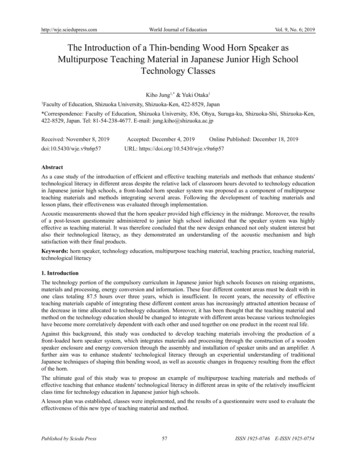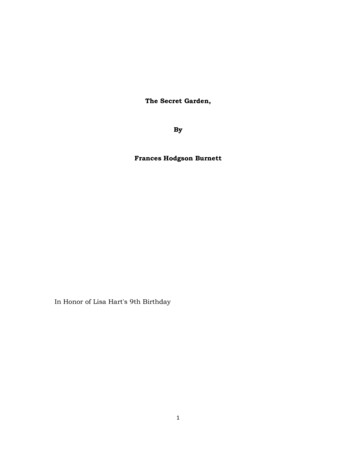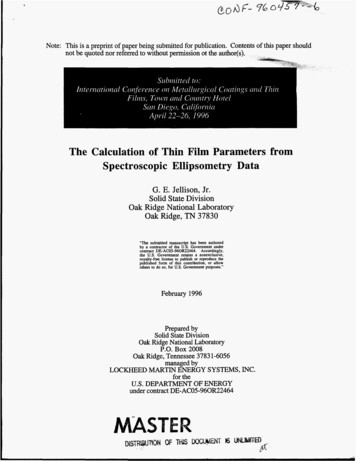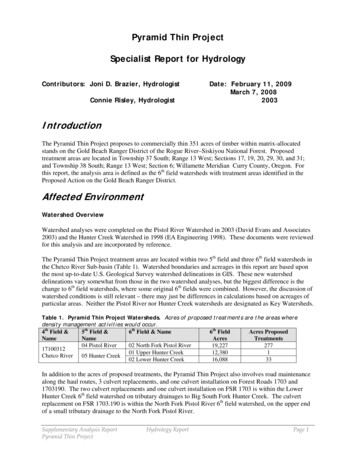
Transcription
http://wje.sciedupress.comWorld Journal of EducationVol. 9, No. 6; 2019The Introduction of a Thin-bending Wood Horn Speaker asMultipurpose Teaching Material in Japanese Junior High SchoolTechnology ClassesKiho Jung1,* & Yuki Otaka11Faculty of Education, Shizuoka University, Shizuoka-Ken, 422-8529, Japan*Correspondence: Faculty of Education, Shizuoka University, 836, Ohya, Suruga-ku, Shizuoka-Shi, Shizuoka-Ken,422-8529, Japan. Tel: 81-54-238-4677. E-mail: jung.kiho@shizuoka.ac.jpReceived: November 8, 2019doi:10.5430/wje.v9n6p57Accepted: December 4, 2019Online Published: December 18, 2019URL: https://doi.org/10.5430/wje.v9n6p57AbstractAs a case study of the introduction of efficient and effective teaching materials and methods that enhance students'technological literacy in different areas despite the relative lack of classroom hours devoted to technology educationin Japanese junior high schools, a front-loaded horn speaker system was proposed as a component of multipurposeteaching materials and methods integrating several areas. Following the development of teaching materials andlesson plans, their effectiveness was evaluated through implementation.Acoustic measurements showed that the horn speaker provided high efficiency in the midrange. Moreover, the resultsof a post-lesson questionnaire administered to junior high school indicated that the speaker system was highlyeffective as teaching material. It was therefore concluded that the new design enhanced not only student interest butalso their technological literacy, as they demonstrated an understanding of the acoustic mechanism and highsatisfaction with their final products.Keywords: horn speaker, technology education, multipurpose teaching material, teaching practice, teaching material,technological literacy1. IntroductionThe technology portion of the compulsory curriculum in Japanese junior high schools focuses on raising organisms,materials and processing, energy conversion and information. These four different content areas must be dealt with inone class totaling 87.5 hours over three years, which is insufficient. In recent years, the necessity of effectiveteaching materials capable of integrating these different content areas has increasingly attracted attention because ofthe decrease in time allocated to technology education. Moreover, it has been thought that the teaching material andmethod on the technology education should be changed to integrate with different areas because various technologieshave become more correlatively dependent with each other and used together on one product in the recent real life.Against this background, this study was conducted to develop teaching materials involving the production of afront-loaded horn speaker system, which integrates materials and processing through the construction of a woodenspeaker enclosure and energy conversion through the assembly and installation of speaker units and an amplifier. Afurther aim was to enhance students' technological literacy through an experiential understanding of traditionalJapanese techniques of shaping thin bending wood, as well as acoustic changes in frequency resulting from the effectof the horn.The ultimate goal of this study was to propose an example of multipurpose teaching materials and methods ofeffective teaching that enhance students' technological literacy in different areas in spite of the relatively insufficientclass time for technology education in Japanese junior high schools.A lesson plan was established, classes were implemented, and the results of a questionnaire were used to evaluate theeffectiveness of this new type of teaching material and method.Published by Sciedu Press57ISSN 1925-0746E-ISSN 1925-0754
http://wje.sciedupress.comWorld Journal of EducationVol. 9, No. 6; 20192. Development of Teaching Material2.1. Characteristic Design ConceptIn this study, a small 2-inch speaker unit characterized by poor middle-bass and strong treble ranges was used asteaching material because it was inexpensive and easily obtained. The characteristic horn design, with two (stereo)front-loaded horns consisting of three pieces of thin bending wood (as shown in Figure 1), was adopted not only toimprove the sound quality of the mid-low range but also to provide an empirical understanding of the effect of thehorn and active bending wood processing. The horn has a horizontal baffle plate installed in each speaker unit.The enclosure was placed below the horn and hinge-jointed on the back side so that it could be opened to install andcontrol electronic parts. Students were also able to devise their own acoustic adjustments by adding materials such ascotton, resulting in an experiential understanding of the effect of the enclosure.Figure 1. 3D Modeling of Design ConceptFigure 2. Tree Views of the Horn SectionPublished by Sciedu Press58ISSN 1925-0746E-ISSN 1925-0754
http://wje.sciedupress.comWorld Journal of EducationVol. 9, No. 6; 2019Figure 3. Tree Views of the EnclosureTable 1. MaterialsMaterialNumber・Spruce (19 140 450)3・Spruce (19 89 102)3・Spruce (19 89 450)2・Spruce (19 40 450)1・Spruce (2.5 40 300)3・Hinge-joint2・Screws and nailsas needed・Adhesive (Vinyl acetate resin)as needed・2-inch speaker unit (φ50)2・USB power cable1・AUX cable1・Amplifier kit (AKIT-2VR2822)1Figure 4. External View of the Front-loaded Horn Speaker System2.2 ProcessingAssembly can be divided into three steps: the horn, the enclosure, and the assembly and installation of electronicparts. For the horn section, as shown in Figure 2: a) each wooden plank was drawn and cut; b) three pieces of thinspruce wood (300mm(L)*50mm (R)*2.5mm(T)) were shaped, dried and seasoned in a process requiring 1 week; c)two holes were drilled in the baffle with a 40mm drill for each 2-inch speaker unit installation; finally, d) the hornsection was finished by bonding two planks and three thin curved pieces of wood with adhesive. For the enclosure,as shown in Figure 3: e) each wooden plank was drawn and cut; f) several small holes were made for electric cablesbefore nail-jointing and bonding. At this point, g) hammered nail-jointing was adopted as an executive-skill process;h) the horn and enclosure sections were hinge-jointed at two points on the back to finish the assembly of wood parts.Published by Sciedu Press59ISSN 1925-0746E-ISSN 1925-0754
http://wje.sciedupress.comWorld Journal of EducationVol. 9, No. 6; 2019Assembly and installation of electronic parts was completed as follows: i) after amplifier assembly, speakers werefixed on the baffle and the circuits were connected to complete the process as shown in Figure 4.2.3 Evaluation of Acoustic PropertiesPrior to lessons, acoustic properties were verified through an instrumental sound test. As a control, a normal hornlesstype was constructed. The test method is illustrated in Figure 5, and Figure 6 shows the results of the acoustic test.The horn speaker had a relatively higher range (400-1000Hz) compared to the normal hornless type. Thus, it hadabundant mid-low frequencies, comparable to a 6-8 inch speaker, which is generally considered adequate in afull-range speaker. It was concluded that the mid-low frequency was enhanced by the effect of the curved-woodhorn.Figure 5. Illustration of the Acoustic Test MethodFigure 6. Acoustic Test Results3. Implementation in Technology Classes as Teaching Material3.1 Lesson DesignAccording to Jung et al. (2018), technology education using bending wood changes students’ stereotypes of wood asrelatively difficult to bend without breaking compared to pliable materials like soft iron. It is reported that this helpsdeepen technological literacy regarding materials and processing and also enhances students’ creative and aestheticdesign skills by allowing them to introduce their own elements. This study sought to extend this approach byenhancing students’ technological literacy regarding energy conversion through an experiential process involving theacoustic effects of the horn speaker, combined with embodiment through the shaping of the bending wood used inthe horn as design and process elements. The lesson plan was established as shown in Figure 7.Published by Sciedu Press60ISSN 1925-0746E-ISSN 1925-0754
http://wje.sciedupress.comWorld Journal of EducationVol. 9, No. 6; 2019Figure 7. The Strategy for Lecture3.2 Lesson PlanThe lesson plan was designed to distribute the new learning points and processing practice so as to balance skill leveland improvement without losing student interest.The plan is shown in Table 2, where a) through i) corresponds to Section 2.2 Processing. The lessons wereimplemented with 2 classes (60 students) in the 2nd year of junior high school. Figures 8-10 show the steps of thelesson.Table 2. Lesson PlanHourObjectives1Listening and surveying for the horn speaker2-5Process a) and e)6-7Process c) and f)8-10Bending wood learning and Process b)11-12Process d) and g)13-17Circuit learning and amplifier assembly18-19Process h) and i)20Listening and evaluation for own productFigure 8. 1st to 7th HourPublished by Sciedu Press61ISSN 1925-0746E-ISSN 1925-0754
http://wje.sciedupress.comWorld Journal of EducationVol. 9, No. 6; 2019Figure 9. 8th to 12th HourFigure 10. 13th to 20th Hour3.3 Questionnaire Results and DiscussionA questionnaire was administered after the lessons. Questionnaire contents are shown in Table 3. A five-pointLikert-scale was used to evaluate student interest and difficulty level. In order to evaluate how much students learnedabout the properties of wood and acoustic structures, free-description items were also included. Questionnaire resultsare displayed in Figure 11 and 12. A large percentage (97%) of students were positive about lesson interest, while 57%were positive about difficulty level. Based on responses to the free-description items, it was concluded that theylearned about the principles of shaping wood, horn effects, and enclosure mechanisms.In order to investigate satisfaction with the speaker as a musical device used in daily life and its influence on musicalenvironments in the home, a questionnaire was administered after a 2-week vacation. In addition, the impressions ofstudents’ families were investigated via free-description items. The content and results of the questionnaire areshown in Table 4 and Figure 13. Results indicated that 79% of students were satisfied with the sound quality of thespeaker and 83% were satisfied with their own products. In addition, responses to the free-description items byfamily members included positive evaluations such as "beautiful sound" and "well made." This suggests that thelesson contributed to the enhancement of self-esteem and communication in the home after the lessons.Table 3. Content of the QuestionnaireItem 1Item 2Item 1Item 2Published by Sciedu PressContentsImpression of bending wood horn speaker productionDifficulty of construction of bending wood horn atSomewhatEasyNeithereasydifficult62Answer⑤ISSN 1925-0746BoringDifficultE-ISSN 1925-0754
http://wje.sciedupress.comWorld Journal of EducationVol. 9, No. 6; ��80%Answer④100%Answer⑤Figure 11. Five-point Evaluation of Interest and Difficulty Level31%45%24%Bending woodMechanism of the horn and enclosureOtherFigure 12. Free-description Items Regarding Learning of Wood Properties of Wood and Acoustic StructureTable 4. Questionnaire for Own ProductsContent1-1Satisfaction with the sound of the speaker1-2Did you notice a difference in sound by opening and closing the speaker?2Satisfaction level with the appearance of the finished product3Did you think that you would like to make something by yourself based on this gure 13. Evaluation of Speaker as a Musical Device in Daily Life and Influence on Home Musical EnvironmentPublished by Sciedu Press63ISSN 1925-0746E-ISSN 1925-0754
http://wje.sciedupress.comWorld Journal of EducationVol. 9, No. 6; 20194. ConclusionThis case study introduced efficient and effective teaching materials and methods that combined different areas inorder to address the lack of classroom hours devoted to technology education in Japanese junior high schools. Thehorn speaker using thin bending wood provides a combination of teaching materials and methods integratingdifferent areas. The implementation of these materials and methods resulted in satisfactory responses to thequestionnaire.In conclusion, the results of this study can be summarized as follows. A front-loaded horn speaker using thin bending wood displayed relatively high quality in the 400-1000Hz rangeand was characterized by abundant mid-low frequencies. On the post-lesson questionnaire, 97% of students responded positively regarding the lessons and 57%responded positively regarding difficulty level. Seventy-nine percent of students were satisfied with sound quality and 83% were satisfied with the finishedproduct. Free-description comments suggested the positive responses of family members such as "beautiful sound" and"well made."ReferencesAkinori, Y. (2011). The property of the wood and processing. Tokyo: Kairyudo.David, A. (2015). Experimental learning: Experience as the source of learning and development (2nd ed.). NewYork: Pearson Education.Japanese Industrial Standards. (2019). Acoustic system speakers. Retrieved 19 November, 2019 ese Ministry of Education. (2008). The revisions of the courses of study for junior high school technology andhome economics. Tokyo: Japanese Ministry of Education.Kazushige, T. (2008). Study on bass reflex type speaker: Design method of phase reversal enclosure. Tokyo:Seibundosinkosha.Kiho, J. (2017). Development of front-loading-horn speaker teaching material for ICT device. Shizuoka UniversityFaculty of Education Research Reports, 48, 161-170.Kiho, J. (2018). Development of thin wood bending teaching materials in technological education in a Japanesejunior high school. International Journal of Environmental & Science Education, 13(2), 187-199.Yuichi, A. (2015). Horn speaker production. Tokyo: Seibundosinkosha.Yuki. O. (2019). Development of a horn speaker by bending wood as a teaching activity. The Japan Society ofTechnology Education, 61(3), 187-194.Yusuke, S. (2019). Multipurpose speaker using thin bending wood. Retrieved 15 November, shed by Sciedu Press64ISSN 1925-0746E-ISSN 1925-0754
Japanese techniques of shaping thin bending wood, as well as acoustic changes in frequency resulting from the effect of the horn. The ultimate goal of this study was to propose an exam










